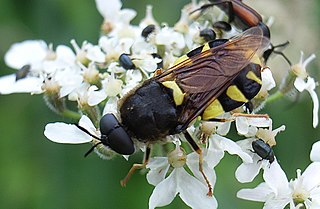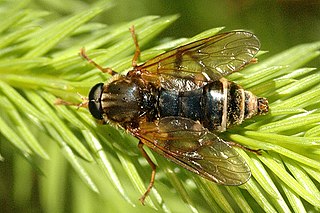
The Brachyceran infraorder Xylophagomorpha is a small group that consists solely of the family Xylophagidae, which presently contains subfamilies that were sometimes considered to be two small related families. Other obsolete names for members of this family include Exeretonevridae and Heterostomidae.

Rhagio is a worldwide genus of predatory snipe flies. Several species in this genus are referred to as downlooker or down-looker flies because they sometimes perch on tree trunks in a head-down position. There are approximately 170 species. They can be distinguished from other rhagionids by the open anal cell on the wings and the lack of a kidney-shaped arista.

Xylota is a Holarctic genus of hoverflies similar in structure to the related genera Chalcosyrphus and Brachypalpoides. As the larvae are saprophytic they're usually found in rotting wood. The adult flies are generally associated with woodland and woodland edges and can often be seen running over the upper sides of leaves. Unlike other syrphids the adults of many species rarely visit flowers preferring instead to gather pollen from leaf surfaces. There are over 100 described species of which 12 can be found in Europe. Seven species have been recorded in Britain. Identification of species has been difficult and identification by photographs is risky.

The Milesiini is a large and diverse tribe of hoverflies. They mimic wasps or hornets.

Stratiomys is a genus of flies in the family Stratiomyidae.

Beridinae is a subfamily of soldier flies in the family Stratiomyidae.
Uramya pristis is a species of fly in the family Tachinidae. It is a parasitoid of Limacodidae moths, and overwinters in its pupal stage.

Rachicerus is a genus of flies in the family Xylophagidae.

Solva is a fly genus in the family Xylomyidae, the "wood soldier flies".

Cyphomyia is a genus of flies in the subfamily Clitellariinae.
Arthropeas is a genus of flies in the family Xylophagidae.

Dialysis elongata is a species of fly in the family Xylophagidae.

Dialysis is a genus of flies in the family Xylophagidae.

Xylophagus lugens is a species of fly in the family Xylophagidae.

Xylophagus is a genus of flies in the family Xylophagidae.

Coenomyia ferruginea is a species of fly in the family Xylophagidae.

Coenomyia is a genus of flies in the family Xylophagidae.

Xylophagus reflectens is a species of fly in the family Xylophagidae.

Rachicerus fulvicollis is a species of fly in the family Xylophagidae.













